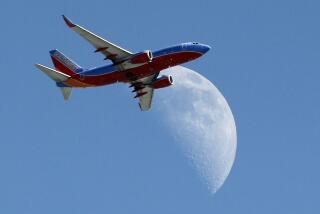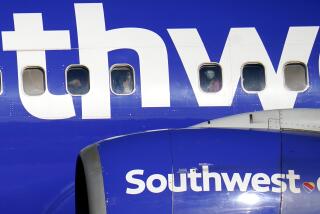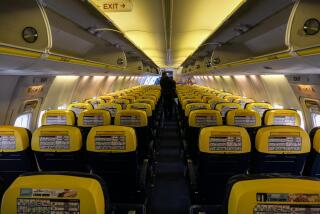Coping With Passengers Who Get High in the Sky
On a flight between London and Houston a passenger climbed into an overhead luggage rack and refused to come down until a stewardess took off her blouse.
On a flight between Berlin and Zurich a woman passenger rushed for the cockpit door, insisting on seeing the captain. When a flight attendant asked her to sit down, the woman took a swing at her. The flight attendant wrestled the woman to the floor and spent the next 30 minutes sitting on the passenger.
And 38 members of an Australian football team on their way to the United States were thrown off a flight in Honolulu after food fights broke out in the cabin and 12 airline seats were ripped out of the plane.
What do all these incidents have in common? Excessive drinking by passengers.
“We think the drinking problem has become quite serious,” says Cindy Yeast, spokeswoman for the Assn. of Flight Attendants (AFA), an organization that represents 21,000 flight attendants.
“Flight attendants are being physically abused by drunk passengers, and there are safety problems as well,” she says.
‘Flagrant Abuse’
“Drunks are accepted in America,” Yeast says. “The whole nation is worried about drugs and yet we have this flagrant abuse of alcohol in the air. We have to face the facts that there are a lot of alcoholic passengers flying on airplanes.”
The real problem, Yeast argues, “is that the airlines don’t want to do anything about it.”
One reason, perhaps, is that the airlines make a lot of money serving booze. Almost 30% of all air travelers order a drink. Last year the airlines served more than 12 million tiny bottles of alcohol to passengers and earned more than $400 million in sales.
“On some of our European and African routes,” says David Coltman, president of British Caledonian Airways, “we offer free liquor. But on transatlantic routes, where air fares are already quite depressed, we sell the booze. It does generate income,” he says.
As a result, as many flights go up, up and away, many passengers are already gone.
One very drunk group was arrested for starting fisticuffs in the sky over Spain. Ironically, a TWA flight attendant was only able to stop a drunk passenger who was trying to take out a window exit during flight by dousing him with champagne.
“Consumption of grape juice (wine, champagne) is certainly increasing faster than hard liquor,” says David Bell, spokesman for Cathay Pacific. “It’s still alcohol, and the effect is still the same.”
The problem has become so noticeable that at least one Asia-based airline has equipped each of its airplanes with a set of handcuffs that flight attendants can use if necessary to restrain a drunk and unruly passenger. “We’ve had to anchor some people to their seats a number of times,” says a spokesman for the airline.
“No one wants to do anything about it,” Yeast says. “We feel we’re in the middle because the airlines don’t want the publicity either. And they won’t back us up,” she says “unless it’s really a severe case. The airlines,” she charges, “almost want you to be beaten up by a drunken terrorist before they will get involved.”
In addition, few airline captains want to press charges against drunk passengers; it means having to return to the city where the passenger was arrested to testify if the case goes to trial. As a result, most airline captains elect to land and deplane the drunk passenger rather than create a bigger scene.
“The problem,” one pilot says, “is one of priorities. If some guy lit up a joint on an airplane, there’d be a quick nonscheduled landing, and the guy would be arrested without question. But if he goes through a fifth of liquor, becomes abusive and endangers safety, we put up with it. It’s a terrible double standard, and we want alcohol considered in the drug-abuse category.”
Don’t hold your breath waiting.
Airlines spend a considerable amount of time planning and promoting their alcohol services. Brands are selected carefully and are often distinct by class of travel.
In addition, detailed time and motion studies are often made to determine how long it takes a flight attendant to serve the booze, and how much can be dispensed on any one flight.
Over the Long Haul
But on airlines that have longer flights, the drinking problems can get serious.
“Most of our flights are long hauls,” Pan Am spokesman James Arey says. “For the large part,” he says, “the amount of liquor we serve passengers is discretionary on the part of the flight crew. We pride ourselves on our ability to recognize when a passenger has had too much to drink. We also do not allow passengers to consume their own booze.”
That doesn’t stop other passengers from trying. One of the biggest problems about passenger drinking, on international flights, is the additional consumption of duty-free alcohol that has been bought on the flight.
“On a number of my flights,” one pilot says, “it has not been unusual to walk the aisles after landing to see lots of empty bottles stuffed into seat backs or lying on the floor. We’ve complained, but no one wants to do anything about it.”
In December the International Civil Aviation Organization rejected a request by airline pilots from around the world that simply asked for a study of the possibility of having airlines collect and stow duty-free alcohol on board, returning the full bottles to passengers upon landing. The ICAO found the suggestion “impractical.”
“I’ll do anything I can not to work the smoking section,” says Lenore Kadish, a flight attendant for TWA. “Because that’s where all the drinkers are, too.
“But my problems aren’t just with abusive drinkers on flights. It’s with the quiet drunks, the folks you can’t wake up after the plane lands. And we feel it can seriously impact our ability to help people in an emergency.”
(In 1983, after an Air Canada DC-9 caught fire and had to make an emergency landing in Cincinnati, investigators discovered that one of the 23 passengers who died had a blood alcohol level of 0.2% and two others had alcohol levels above 0.1%, which could have easily impaired their ability to make it to an emergency exit. Most states consider people with blood alcohol levels above 0.1% to be legally drunk.)
“The drinking problem goes way beyond cocktails in the airplane,” Kadish says. “The problems usually start at airport bars before passengers board. We need to monitor the boarding process more closely to prevent more problems once we’re in the air.”
(In Australia, the Airline Crew Assn. has asked airlines to make passengers subject to breathalyzer tests before boarding.)
Use a Lot of Charm
“Most of these in-flight drunk passenger problems in the cabin are manageable,” British Caledonian’s Coltman says. “The way to deal with it is with a lot of charm. We’re used to it,” he says. “After years of transporting oil rig crews to Libya and Saudi Arabia, we’re prepared for the passengers who drink.
“Most of the time,” Coltman reports, “the drunk passengers are men. A well-trained woman flight attendant can usually handle a drunk male passenger. If a woman asks him to sit down and shut up, he probably will. If I do it, he’ll probably take a swing at me.”
Some others, like Rep. Cardiss Collins (D-Ill.) are becoming concerned about possible drinking problems in the cockpit. Collins just introduced legislation that would give the Federal Aviation Administration access to the National Drivers’ Registry to help identify pilots who have been convicted of motor vehicle offenses, such as drunk driving.
Collins is chairman of the House government operations subcommittee on government activities and transportation. The panel has already held hearings on drug and alcohol abuse by pilots.
What’s a little scary is that the Collins Bill (HR 718) is based in part on a finding by the inspector general of the U.S. Department of Transportation that indicates several thousand pilots have been convicted and/or had their automobile driver’s licenses suspended or revoked.
More to Read
Sign up for The Wild
We’ll help you find the best places to hike, bike and run, as well as the perfect silent spots for meditation and yoga.
You may occasionally receive promotional content from the Los Angeles Times.






